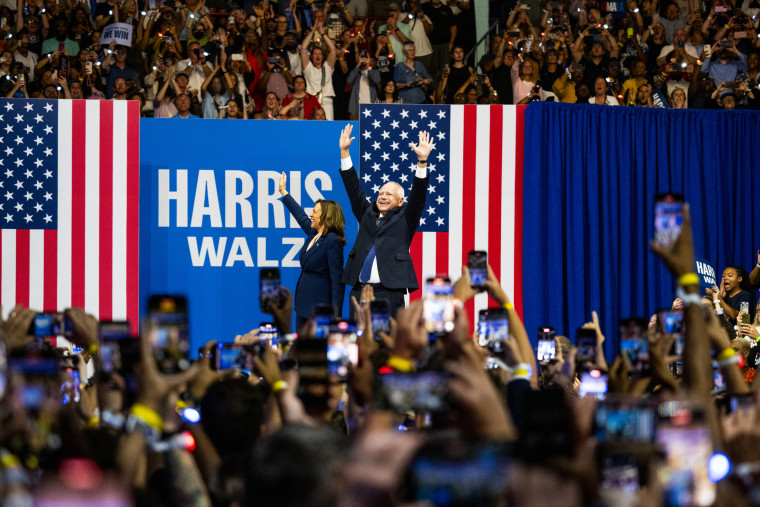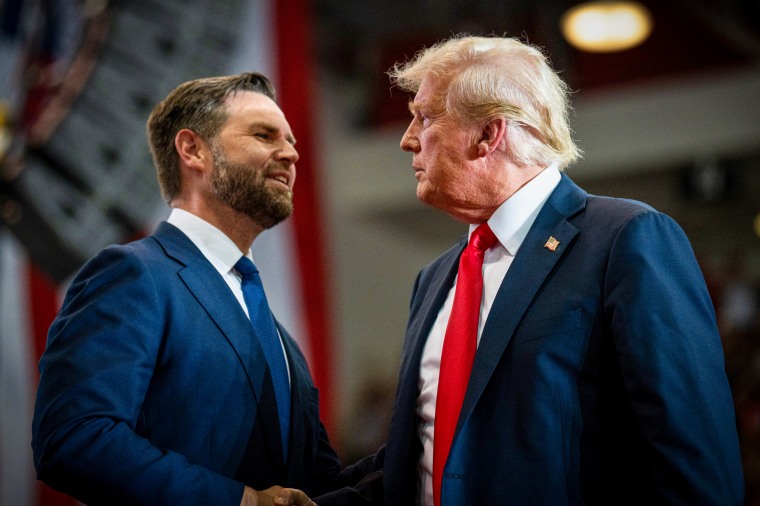On July 19, the day after the GOP convention ended, I wrote that “we are getting awfully close to the moment where it might be fair to say, ‘Throw out everything you thought you knew about this election.’”
Well, that moment arrived two days later, when President Joe Biden officially dropped his re-election bid and passed the baton to Vice President Kamala Harris.
Now, with her choice of Minnesota Gov. Tim Walz as her running mate, both major parties have their tickets set for a 90-day sprint to Election Day. This campaign went through a massive reboot over the last three weeks, and the computer has finally finished whirring and resetting and updating a bunch of new software for various apps and programs.
Among the predictions I made in that column was that two things would most likely change with a new ticket for the Democrats: Interest in the election among all voters would increase, particularly among some key voter groups the Democrats are counting on, like young people and African Americans. And renewed interest in the new Democratic ticket might lessen the interest in the various third-party candidates. Those two developments alone would increase the variance in possible outcomes for November.
Early polling indicates a renewed interest in the campaign overall — and it’s not just polling. The fundraising has been a bigger boon than even the most optimistic Democrats anticipated. The various “attention metrics,” like TV ratings and social media trends, also show interest in the campaign is up near levels in 2008 and 2020, two of our higher interest/turnout elections of my lifetime. That’s after having been down at unusually low levels before.
And then there’s the collapse of the third-party candidates. A Biden-Trump rematch was a perfect storm for a rise in the third-party presidential vote share. And at times, some polls showed the share of non-major-party voters hitting nearly 25%.

That is no longer the case, and I highly doubt we will see the combined third-party vote get into double digits. It has been especially fascinating to watch the collapse of support for Cornel West and Jill Stein, who are both running to the left of the Democrats and very aggressively on the issue of Gaza.
And the new interest in the campaign, combined with more just plain weird information that the public is learning about Robert F. Kennedy Jr., has shown that what’s left of his support may be folks who aren’t persuadable for either major party. He might have simply cornered the “gadfly” market of American politics. I’m still expecting Kennedy to drop his campaign at some point and endorse Trump. He has all but hinted a Trump victory is his preferred outcome.
All of this means the country is basically where it has been since the 2000 election: deeply polarized and, essentially, evenly divided. Remember, five of the six presidential elections since 2000 have been decided by 5 percentage points or less, and it’s likely this election will also be decided by 5 points or less. (Only five elections in the entire 20th century were decided by that small margin.)
So let’s delve into what we don’t know. Here are a series of questions to ponder as you try to figure out which way this election is leaning.
The state of the race
Let’s start off with this basic one: Is Harris winning right now? Or is Trump losing? Is it some combination of both?
I’ve been highly cautious in answering the question about Harris’ actual viability in this election. Until the country elects its first female president, there’s always going to be some doubt about whether voters are ready to elect a female commander in chief. But it’s clear that Trump has been completely thrown off his game, and right now, he’s actively making unforced errors that could cost him this election.
From his damaging decision to question Harris’ mixed-race background — at the National Association of Black Journalists, no less — to the strategy-free sideswipe he made in Georgia against the state’s popular GOP governor, Brian Kemp, it certainly appears as if Trump is off his game. On July 18, the night he delivered his convention acceptance speech, he was in cruise control. From surviving an assassination attempt to the surprising unity he projected at his convention to the feeble performance by Biden at a variety of public events, Trump knew how to win a rematch with Biden.
But he’s not running against Biden anymore, and it’s clear he is lamenting that more than any of us realized. Many people close to Trump have indicated to me how focused he was on avenging his defeat at Biden’s hands in 2020. It really bothered him that he lost to someone who, in his mind, wasn’t worthy of defeating him.
This is how those close to Trump explain his obsession with questioning the validity of 2020. He just can’t accept that Biden beat him by being the anti-Trump — less in your face, less erratic, less aggressive. To accept defeat by Biden is to accept that Trump’s own worse instincts are what doomed him in 2020. And while I’ve pledged not to put Trump on the couch, he wouldn’t be the first narcissist who can’t accept rejection.
But it’s not just losing Biden as an opponent that has rattled Trump — it’s having to run against a woman. It’s worth noting how he seems to dial up his personal venom when he’s questioned by a woman, whether it’s a woman from his own party challenging him for the GOP nomination (see Carly Fiorina in 2016 and Nikki Haley in 2024), a woman from his own party questioning his commitment to the ideals of America and the Constitution specifically (see Liz Cheney) or women he has to deal with as his equals (think then-House Speaker Nancy Pelosi, Hillary Clinton and now Kamala Harris). Trump has a history of debating women who question him in the most demeaning and unappealing way.
Trump already has a substance issue with many female voters when it comes to reproductive rights, but those personal attacks on Harris could truly backfire.
What the VP picks mean

Neither party used its VP pick to virtue signal to the disaffected middle. Now what?
That is the biggest known unknown of this campaign: who can appeal to what’s left of the middle. If you worry about the progressive lean of the Democrats and you simultaneously are turned off by the MAGA lean of the Republicans, who do you end up voting for if neither party has made an overt attempt to appeal to you?
Now, both campaigns will take issue with the idea that their vice presidential picks aren’t appealing to some key swing-voting constituencies. Both campaigns cite the Midwestern roots of Vance and Walz as a way to appeal to voters in the crucial states of Michigan, Pennsylvania and Wisconsin. But the reality is that Walz isn’t to the right of Harris and, clearly, Vance isn’t to the left of Trump.
A pick of either Sen. Mark Kelly of Arizona or Pennsylvania Gov. Josh Shapiro would have been a clear virtue signal to the center by Harris, as both are to her political right within the confines of the Democratic Party, at least on a few key issues, including the border (Kelly) and school vouchers (Shapiro), just to name a few. Had Trump picked Haley or Virginia Gov. Glenn Youngkin, the pick would have been viewed similarly, as a virtue signal to the center-right wing of the GOP.
But both campaigns went toward their bases, which is also an indication of where both campaigns see this election. They view it as a turnout election, not a persuasion election. In fact, my hunch is that Harris decided against any vice presidential pick who was going to cause any level of internal tension in the Democratic Party.
In the short term, one could understand that thinking. She has been the official party leader for about two weeks, and the last thing she needs is a series of ideological brushfires at her convention over Gaza, vouchers or immigration. It’s why the Walz pick is already being seen as a “do no harm”-style VP selection.
(I do wonder whether the Harris-Walz ticket is ready for the Trump-Vance campaign’s intention to relitigate all things George Floyd with Walz — and if it is, whether it sees that as a net positive or negative.)
Here’s the bottom line: Neither Trump nor Harris has many obvious opportunities to virtue signal to the middle. The VP picks were among the last of those opportunities. It appears we are headed for an October when both campaigns simply try to disqualify the other candidate with the skeptical middle and try to herd those voters to the ticket that least offends their sensibilities.
The 'change' question
Of course, this election may now play out in a number of ways. For instance, what if this election is simply 2016 in reverse?
In that scenario, the “childless cat ladies” attack line on Democratic voters by Vance is akin to the “basket of deplorables” attack Hillary Clinton made against Trump voters.
But Trump is also similar to Clinton in another way from 2016. Voters thought they already had a sense of what kind of presidency Clinton would conduct, just like they do now with Trump. In 2016, Trump was new and change, while Clinton was status quo. In 2024, Trump’s status quo, and Harris is new and change.
Many of us spend a lot of time analyzing politics as if it’s complicated, and yet sometimes, politics isn’t that complicated. If a majority of the country doesn’t like the direction of the country, it is going to search for someone new. And while Trump isn’t in office, he’s not new. Harris may be Biden’s vice president, but her election would signify something very new and different. Toss in concern about the massive upheaval Trump’s Supreme Court nominees made by overturning Roe v. Wade and one can see a very straightforward and simple explanation for a Trump loss to Harris.
A few other variables are poised to play some role in this campaign, and the extent is unclear. There’s Trump’s age: As Haley said a few times on the campaign trail, it’s possible that the first party that ditches its 80-year-old standard-bearer would be rewarded, which could help Harris.
The world appears more unstable today than it did four years ago, and if concern over the direction of American foreign policy is more front and center in the fall, it’s possible Trump’s experience being president is seen as an asset to some undecided voters.
And then there’s the economy, which is both strong in some places (jobs) and weak in other places (cost of living). A decided negative turn on the nation’s economic outlook in the next 60 to 90 days would also be more likely to benefit Trump.
Altogether, what appeared to be an election in the mold of 1980, 1992 or 2020 — the last three elections in which incumbent presidents lost — is now on a different trajectory.
The race is still winnable for Trump, but it’s a much tougher for path for him. Harris’ path to victory is better than Biden’s, but it’s no sure thing, either. She’s still got a lot of blanks to fill in with the American electorate. Vice presidents are both famous and unknown.
How she fills in those blanks in the next 30 days will go a long way in deciding whether she breaks the country’s ultimate glass ceiling in about 90 days.
